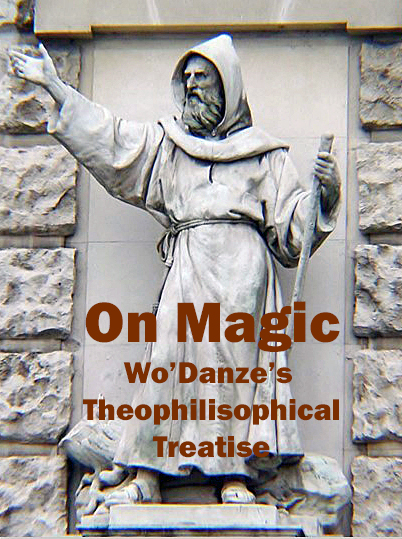Ritual: Conductors, Conduits and Control
While magic, per se, is the application of life forces to achieve change, the caster shapes and modulates the force. The force is conducted from the source through the magi to the target. To contain, modulate, and shape the force into the desired effect, the caster uses their will to form the force. To amplify the will and to insulate the caster from negative feedback from the forces, the magi uses ritual to concretize a force pathway. Words, movement, tools and components are building blocks used in ritual to form the pathway to channel the will to shape the force to achieve the desired result.
Some items or needed building blocks of ritual are unique to a particular type of force or a specific use. For example, as noted, spirit force uses an imaginal space to create force modulation, whereas elemental force is considered the most wild and needs more external constraint to reinforce most casters’ will to be effective. However, with the Elvin and Half-Elvin races, some innate brain function requires less a need for tools or components for elemental magic. In addition, the Elvin family of An’Liath has learned to imbue wands and staves to amplify the magi’s will greatly and reduce the need for tools and components further. Similarly, dried fire toad skin often is a ritual component in elemental fire magic and holy water is commonly used in divine magic’s.
With certain types of force, or certain casters, sheer force of will or the substituted will from a divine or infernal source can cast a desired spell with a minimum of words, movement, tools or components–sometimes a mere thought or single utterance is all that is necessary to release enormous effects. For example, high-level priests and priestesses require less lengthy prayers and incantations than novitiates to their orders. The more accomplished, the higher the rate of transfer of force. A more practiced or better completed ritual will yield a higher force transfer, resulting in a more pronounced end effect. While sometimes higher yield of force is good, most times it also requires a requisite increase in insulation and control to not result in damage or force blowback.
Words, Prayers, Incantations
The most literal way to shape the force of magic is with the will of the caster. Will is the mental enactment of intentionality to bring about a change in the real world. Words are symbolic tokens of thoughts embodied to work in the world. Thus, prayers and incantations transact the inner to the outer. Ritual speech is formal, pedantic and with a tendency to the loquacious. In elemental magic, the language is even more odd and wild, or given the Elvin affinity for the element, in the Elvin tongue. Dark magic uses secret names and words to create barriers. In divine magic, words should implore, placate, revere and praise the divinity to act on the priests or priestesses behalf and in most cases a prayer comprises five elements: the adoration, confession, thanksgiving, supplication and request. In comparison, an incantation is a longer liturgical speech with more elements to fulfill the greater complexity needed for the will to create a safe pathway to channel the life force to act as desired.
Movement, Dance and Motion
Another way to literally shape the force of magic is with motion during the ritual. Force is moved, shaped and modulated and certain motions or motion motifs are commonly used. Right-handed motions are for active shaping, left-handed motions for passive shaping. Clockwise rotations are calming and increase flow, while counterclockwise rotations increase turbulence and slow flow. Serpentine movements blend or twist forces, swaying movements summate forces, while prostration and kneeling show reverence and deference to a divine and infernal entities.
Ritual Tools
Ritual tools are common durable items that are used in the directing and modulation of force in casting a spell or incantation. They can amplify the casters’ will or act as grounding or insulating factor to prevent blowback of force. Common examples of ritual tools include altar, brazier, wand/staff, cup/chalice, athame/boline, and bells. Most practitioners have their own standard set for liturgical work, many also have a traveling set. Guilds and orders will have a special set for community rituals.
Ritual Components
Ritual components are items used as building blocks to increase the efficiency, quality, or safety of a ritual or spell. Some are one time use items that are consumed in the ritual’s process. Others are preserved and reusable, but of significance to a specific type of magic, spell or process, though not a basic tool. Components fall in to one of four families; augmenter, binder, potentiater, or solvent. Augmenters increase yield, efficiency, or safety. Binders allow the effect to be tied to a corporeal body, and these are used in imbuing weapons, talismans, tomes, scrolls and other items. Potentiaters increase the length of the effect or the range over which the effect is capable. Solvents are used to sublimate components into more complex and potent mixtures.
Grimoires, Bibles and Cookbooks
Ritual liturgies, research on tools and components, and prior successful incantations and spells are kept in the magi’s grimoires. These tomes are seeded with exercises and practices from the master during the novitiates’ training. Upon attaining the rank of master, most practitioners will re-consolidate the most useful data to a new book. Some collect multiple volumes over time and others have specific versions or volumes for travel, community use, or dueling. Bibles are like grimoires in that they are sacred texts but contain data specific to their deity along with the ritual liturgies. So-called cookbooks are used by seekers to begin the process of development of their own grimoire, but with non-magical tasks and data.







